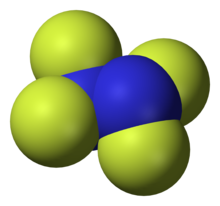
Back تترافلوروهیدرازین AZB Tetrafluorhydrazin Czech Stickstoff(II)-fluorid German تترافلوروهیدرازین Persian Tétrafluorohydrazine French Tetrafluorohidrazina ID Tetrafluoroidrazina Italian 四フッ化二窒素 Japanese Тетрафторгидразин Russian Tetrafluorohidrazin Serbo-Croatian

| |

| |
| Names | |
|---|---|
| IUPAC name
1,1,2,2-tetrafluorohydrazine
| |
| Other names
Tetrafluorohydrazine, perfluorohydrazine, UN 1955
| |
| Identifiers | |
3D model (JSmol)
|
|
| ChemSpider | |
| ECHA InfoCard | 100.030.091 |
PubChem CID
|
|
| UNII | |
CompTox Dashboard (EPA)
|
|
| |
| |
| Properties | |
| N2F4 | |
| Molar mass | 104.008 g·mol−1 |
| Appearance | Colourless gas |
| Melting point | −164.5 °C (−264.1 °F; 108.6 K)[1] |
| Boiling point | −73 °C (−99 °F; 200 K)[1] |
| Hazards | |
| Occupational safety and health (OHS/OSH): | |
Main hazards
|
Explosion |
| Lethal dose or concentration (LD, LC): | |
LD50 (median dose)
|
10 mL/kg (rat, intraperitoneal)[2] |
LC50 (median concentration)
|
|
Except where otherwise noted, data are given for materials in their standard state (at 25 °C [77 °F], 100 kPa).
| |
Tetrafluorohydrazine or perfluorohydrazine, N2F4, is a colourless, nonflammable,[2] reactive inorganic gas. It is a fluorinated analog of hydrazine.
- ^ a b Greenwood, Norman N.; Earnshaw, Alan (1997). Chemistry of the Elements (2nd ed.). Butterworth-Heinemann. ISBN 978-0-08-037941-8.
- ^ a b c Cite error: The named reference
pubchemwas invoked but never defined (see the help page).